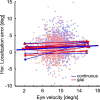Spatial localization during open-loop smooth pursuit
- PMID: 36816133
- PMCID: PMC9932511
- DOI: 10.3389/fnins.2023.1058340
Spatial localization during open-loop smooth pursuit
Abstract
Introduction: Numerous previous studies have shown that eye movements induce errors in the localization of briefly flashed stimuli. Remarkably, the error pattern is indicative of the underlying eye movement and the exact experimental condition. For smooth pursuit eye movements (SPEM) and the slow phase of the optokinetic nystagmus (OKN), perceived stimulus locations are shifted in the direction of the ongoing eye movement, with a hemifield asymmetry observed only during SPEM. During the slow phases of the optokinetic afternystagmus (OKAN), however, the error pattern can be described as a perceptual expansion of space. Different from SPEM and OKN, the OKAN is an open-loop eye movement.
Methods: Visually guided smooth pursuit can be transformed into an open-loop eye movement by briefly blanking the pursuit target (gap). Here, we examined flash localization during open-loop pursuit and asked, whether localization is also prone to errors and whether these are similar to those found during SPEM or during OKAN. Human subjects tracked a pursuit target. In half of the trials, the target was extinguished for 300 ms (gap) during the steady-state, inducing open-loop pursuit. Flashes were presented during this gap or during steady-state (closed-loop) pursuit.
Results: In both conditions, perceived flash locations were shifted in the direction of the eye movement. The overall error pattern was very similar with error size being slightly smaller in the gap condition. The differences between errors in the open- and closed-loop conditions were largest in the central visual field and smallest in the periphery.
Discussion: We discuss the findings in light of the neural substrates driving the different forms of eye movements.
Keywords: localization; localization error; open-loop SPEM; open-loop eye movement; smooth eye movements; smooth pursuit.
Copyright © 2023 Dowiasch, Blanke, Knöll and Bremmer.
Conflict of interest statement
The authors declare that the research was conducted in the absence of any commercial or financial relationships that could be construed as a potential conflict of interest.
Figures







Similar articles
-
An fMRI study of optokinetic nystagmus and smooth-pursuit eye movements in humans.Exp Brain Res. 2005 Aug;165(2):203-16. doi: 10.1007/s00221-005-2289-7. Epub 2005 Apr 29. Exp Brain Res. 2005. PMID: 15864563
-
Expansion of visual space during optokinetic afternystagmus (OKAN).J Neurophysiol. 2008 May;99(5):2470-8. doi: 10.1152/jn.00017.2008. Epub 2008 Feb 27. J Neurophysiol. 2008. PMID: 18305092 Free PMC article.
-
Eye Position Error Influence over "Open-Loop" Smooth Pursuit Initiation.J Neurosci. 2019 Apr 3;39(14):2709-2721. doi: 10.1523/JNEUROSCI.2178-18.2019. Epub 2019 Feb 1. J Neurosci. 2019. PMID: 30709895 Free PMC article.
-
Open-loop and closed-loop optokinetic nystagmus in squirrel monkeys (Saimiri sciureus) and in man.Prog Brain Res. 1989;80:183-96; discussion 171-2. doi: 10.1016/s0079-6123(08)62212-8. Prog Brain Res. 1989. PMID: 2699364 Review.
-
Contribution of the nucleus of the optic tract to optokinetic nystagmus and optokinetic afternystagmus in the monkey: clinical implications.Res Publ Assoc Res Nerv Ment Dis. 1990;67:233-55. Res Publ Assoc Res Nerv Ment Dis. 1990. PMID: 2106153 Review.
References
-
- Becker W., Fuchs A. F. (1985). Prediction in the oculomotor system: Smooth pursuit during transient disappearance of a visual target. Exp. Brain Res. 57 562–575. - PubMed
-
- Binda P., Morrone M. C. (2018). Vision during saccadic eye movements. Annu. Rev. Vision Sci. 4 193–213. - PubMed
-
- Blanke M., Harsch L., Knoll J., Bremmer F. (2010). Spatial perception during pursuit initiation. Vision Res. 50 2714–2720. - PubMed
LinkOut - more resources
Full Text Sources
Miscellaneous

